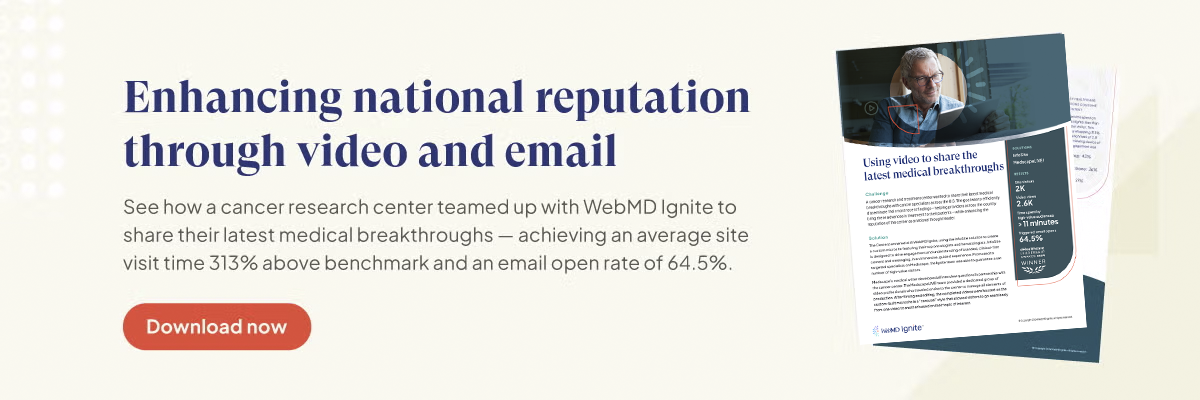5 steps to strategically allocate your healthcare marketing budget

In an ideal world, marketers actively research, strategize, and plan their budgets to achieve business goals. However, many organizations still use a traditional, top-down approach. Regardless, it’s crucial to spend your marketing budget strategically to prioritize big-picture goals, such as growing high-value service lines.
So, how can healthcare marketers make the most out of their budgets? Let’s explore a few steps you can take:
Step 1: Align marketing goals with enterprise objectives
First things first. Healthcare marketers must have a solid understanding of their organization’s initiatives and overarching business goals.
- Within our organization, what service lines have a need and capacity for growth?
- Where are the known or suspected threats around volumes and referrals?
- What service lines are competing organizations going after?
- Where does our organization see the most opportunity?
- For particular service lines, what efforts have been made or planned toward recruitment? Are there new physicians with specific specialties?
- Are there first-in-market initiatives, i.e., procedures, surgical equipment?
With enterprise objectives in mind, you can then prioritize marketing dollars to support efforts that will align and ultimately show progress toward those goals.
Step 2: Invest in the brand
It’s important that a certain amount of your marketing budget is invested in strengthening your brand. Consumers don’t buy what they don’t know, and they aren’t likely to seek out treatment from a brand that they are entirely unfamiliar with. You can do this by providing useful, trustworthy information about health and disease on your website or by sponsoring a community event.
A health system with a recent name change or new practice location will likely need to spend more money on brand-focused efforts – even upwards of 30 to 40 percent – but a dedicated branding campaign executed early on will reap exponential rewards as your market position gains strength and authority. There is a direct correlation between brand strength and cost per lead: Become an integral, trusted voice in your community and individuals — both consumers and providers — will think of your name first during their moment of need, reducing the spend necessary to acquire, retain, and build loyalty.
Step 3: Get familiar with the competition
While your organization will certainly want to allocate budget according to your unique resources, needs, and strategic priorities, an analysis of your competitors’ marketing tactics (and estimated spending) prior to planning out your own can be incredibly helpful.
A competitive analysis can provide valuable insight into the best performing channels within the geographies your competitors are most active, and even a baseline percentage-based breakdown (if only an estimate) of overall spend. There are a variety of online tools available — including both free and paid iterations — that allow marketers to track competition and estimate the spend across various marketing and social channels. Google trends or the page transparency tool on your competitor’s Facebook page are both good places to start.
Step 4: Determine geographic priorities
When allocating your healthcare marketing budget, you not only want to consider a multitude of business objectives and what your competition is already doing, but you also have to consider the geographic markets that you need to support. For instance, a young northern market with strong potential for growth, or a western market that needs to be defended against a top competitor.
As a smart marketer, you understand that each of your priority geographies behaves differently — the northern market might have a younger, more digitally fluent population and be located in an urban area. In this case, you might be best off prioritizing spend on digital and programmatic channels like social media advertising and Connected TV (CTV). In the western market, on the other hand, you might choose to spend more money on billboard advertising, knowing that the region is less thickly settled (and therefore cheaper to purchase billboard space).
Step 5: Prioritize targeted messaging
Brand-focused marketing is developed to improve the community’s trust in your organization — it serves a broad, generalized purpose, using content and messaging that is generally based upon awareness and an overarching vision or mission statement. However, it’s just as important to create individualized, hyper-targeted messaging to attract specific personas and make your target audience feel as though you understand them. Healthcare, after all, is an innately personal industry.
Look for geographies or service lines that are already well-established from a brand awareness perspective. Then, go after these populations with hyper-targeted, precision marketing efforts that ask for a specific “order”, e.g., a personalized email that prompts a patient to schedule an annual check-up.
Your martech investments can provide critical insights into consumer and provider groups who are most valuable for individualized messaging — as well as where, when, and how often to deploy said messaging. For instance, when looking at your priority oncology service line, you may notice that the majority of new patients acquired in the past year were between the ages of 35 and 65, with a colorectal cancer diagnosis, and located in markets outside of your CSA (combined service area). You could experiment with increasing spend on this year’s engagement and outreach campaigns to referring specialists, as well as bidding on more competitive keywords to increase visibility among consumers researching for care in these markets.
Final thought
Marketers need to be careful to avoid spreading budgets too thinly across too many channels. By using this step-by-step approach, you’ll avoid tipping the scale too far into one channel or segment, have the ability to adapt your campaigns over time, and reallocate your resources as necessary.





